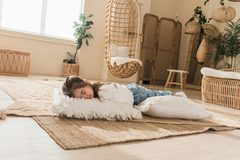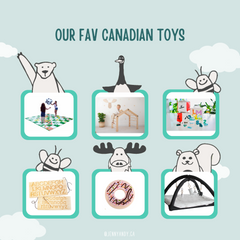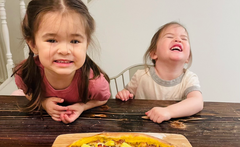Did you know that jumping is an important gross motor developmental milestone for your toddler? Jumping starts at around 16-18 months of age and supports many areas of development.
Why is jumping important?
Here are some areas of development that are enhanced by jumping:
-
Muscle Development
Jumping requires a lot of strength and power and so it’s very important for developing muscles that are important for all gross motor movements.
-
Bone Development
Just as jumping strengthens the muscles, jumping is also important for bone growth and strengthening.
-
Motor Planning & Sequencing
Jumping requires proprioception (the awareness of the position of our own bodies) and that we continuously calibrate our motor planning and sequences. In order to execute the proper movements, your toddler uses their motor planning skills to judge distance, assess how much power is needed to jump that distance (or height), and execute the jump to land properly. All this requires planning the right movements in the proper sequence.
-
Balance
Balance is required to properly execute the jump. As your toddler learns to jump, they begin to fine-tune their balance in order to achieve a proper jumping stance and land back on their feet (or in a foam pit!)
-
Overall Health
Physical activity plays an important role in overall health, and jumping is a big part of a toddler’s physical activity. Research shows that less and less children are physically active, putting their ability to master jumping at risk. Not mastering jumping can discourage children from engaging in physical activity.
-
Social Interaction
Jumping is a big part of children’s play, and children who haven’t mastered jumping, or aren’t confident in their jumping abilities, may avoid participating in group activities, games, and sports that are important for building social skills and boosting self-confidence.
-
Sensory and Self-regulation
Jumping can be an important way for children to learn to self-regulate, especially for children with neurodevelopmental disabilities such as autism or ADHD. Jumping provides vestibular and proprioceptive input, provides calmness for sensory-seeking children which helps with focus and attention, and can wake up children who have an under-responsive system.
Tips to Practice Jumping
When your toddler is ready, it’s important to practice and fine tune their jumping skills, just like any other skill. Here are some tips to get you started.
Practice in various environments
Create opportunities to practice jumping in various environments. Practicing with bare feet will also allow your child to interact with different and unique textures, giving your child various sensory experiences (why is sensory play important?).
When starting out, try practicing on soft surfaces like gym mats, carpet, and grass and eventually graduate to harder surfaces. This ensures safety with the added bonus that each surface will present a different and unique challenge for your toddler.

Use peer play
When possible, use other children to model jumping. Peer play can be extremely beneficial to master this motor milestone as children often observe and learn from other children.

Use a trampoline with supports
Jumping on a trampoline with a support bar is a great way for the children to develop their jumping skills independently. They can use their upper bodies with the support bar to build the strength and motor planning needed until they’re ready to start depending on their lower body strength.
Get this foldable trampoline with handle on Amazon.ca
Fun Jumping Activities to Try
- Cut out fun shapes or letters and practice jumping from one to another
- Build an obstacle course with small objects to jump over (hula hoops, pool noodles, pillows, etc.)
- Jump over (or in) puddles on a rainy day
- Pretend to be an animal (i.e. frog jump)
- Set up a soft crash pad to jump into (i.e. a pile of leaves, a foam pit, padded walls and a pile of pillows, etc.)
- Dance to guided songs. We love The Freeze Dance and Sleeping Bunnies. Check them out below!
About the author:
Sam is Jenny & Andy’s Marketing Coordinator. Before she joined Jenny & Andy, she was a speech therapy associate and behaviour therapist who spent 5 years working with young toddlers with autism and other exceptionalities and their families.
Her therapy sessions required her to work collaboratively with Speech-Language Pathologists, Board Certified Behaviour Therapists, Occupational Therapists, Teachers, and Registered Early Childhood Educators.




